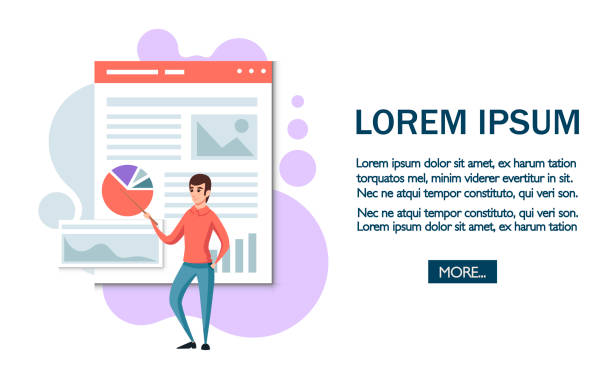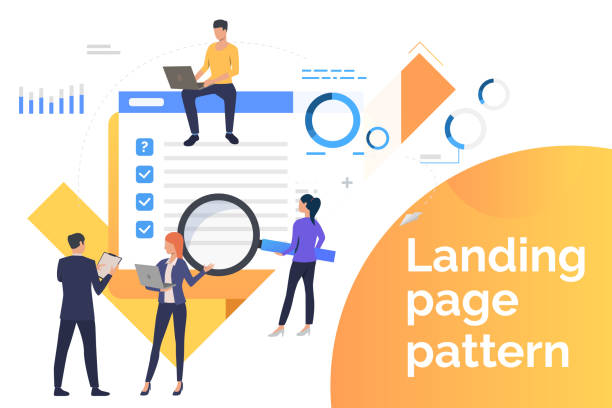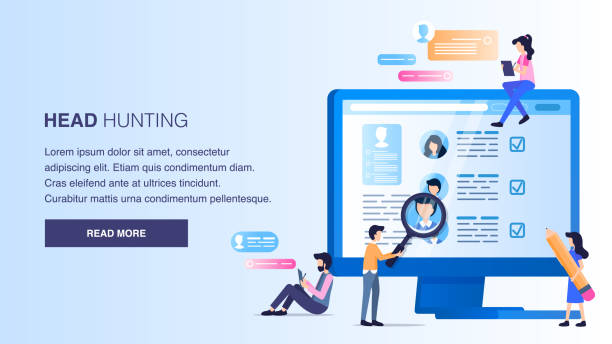An Introduction to the World of Responsive Website Design: An Inevitable Necessity

In today’s world, where users access websites from various devices, from small smartphones to wide desktop monitors, the importance of Responsive Web Design has become more apparent than ever.
#Responsive_Websites are designed with complete flexibility to adapt to the user’s device screen size, providing an optimal and seamless experience.
The era of fixed and static designs is over; today, a successful website is one that can maintain an attractive appearance and smooth performance on any platform.
This approach not only improves user experience (UX) but also plays a vital role in SEO (Search Engine Optimization) success.
This article provides an explanatory and educational review of various dimensions of this concept, so you can learn everything you need to understand and implement an adaptive website design.
Do you know how a website can intelligently respond to changes in screen dimensions, and why this capability has become a standard today? We will answer these questions below and engage your mind with the challenges in this area through question-provoking content.
Does your current website reflect your brand’s credibility as it should? Or does it drive away potential customers?
RasaWeb, with years of experience in designing professional corporate websites, is your comprehensive solution.
✅ A modern, beautiful website tailored to your brand identity
✅ Significant increase in lead generation and new customers
⚡ Contact RasaWeb now for a free corporate website design consultation!
Technical Principles of Responsive Design at the Heart of Modern Web

Responsive Web Design is built upon specific technical foundations, the understanding of which is essential for every developer.
The three main pillars of this approach include Media Queries, Flexible Grids, and Flexible Images.
Media Queries allow specific CSS styles to be applied based on device characteristics, such as screen width.
This capability enables designers to define different layout versions for various screen sizes without the need to create separate websites.
Flexible grids use relative units like percentages for element widths instead of fixed pixels, which causes the layout to automatically adjust to the available space.
Similarly, flexible images ensure that images never overflow their containers and display correctly at any size by setting their maximum width (max-width) to 100%.
This section provides a technical and educational deep dive into these concepts and explains how they work.
Understanding these foundational elements is crucial for implementing any successful responsive website design and helps you maintain full control over your site’s display across different devices.
Advantages of Adaptive Website Design for Users and Businesses

Responsive Web Design is not just a trend; it’s a strategic investment for any business.
From a user’s perspective, adaptive websites offer a seamless, fast experience without the need for zooming or horizontal scrolling, leading to increased satisfaction and reduced bounce rate.
When users can easily navigate your site, their likelihood of converting into customers or revisiting the site increases.
From a business perspective, there are numerous advantages:
| Feature | Responsive Design | Non-Responsive Design |
|---|---|---|
| Mobile User Experience | Excellent and Optimized | Poor and Requires Zoom |
| Development and Maintenance Costs | Single codebase, Cost-effective | Requires separate versions, More expensive |
| Search Engine Optimization | Google’s preference, Better ranking | Likely lower mobile ranking |
| Broad Market Access | Supports all devices | Limited to desktop or a specific device |
This section provides an analytical and guidance-oriented discussion of the importance of these benefits, showing why responsive design is a business imperative.
An adaptive website not only attracts more visitors but also significantly contributes to branding and building credibility.
Key Tools and Technologies in Responsive Design

To effectively implement Responsive Web Design, developers need a set of tools and technologies.
In addition to HTML and CSS, the use of CSS frameworks like Bootstrap or Foundation is highly recommended.
These frameworks greatly accelerate the development process and ensure website compatibility across various devices by providing pre-designed grid systems, responsive UI components, and ready-to-use styles.
Using CSS preprocessors like Sass or LESS can also help better manage and organize CSS code, especially in large projects with multiple media queries.
Furthermore, browser testing and debugging tools (like Chrome DevTools) offer the ability to simulate different devices, helping developers inspect their site’s display across various screen sizes and resolve potential issues.
This section, with a technical and guidance-oriented approach, introduces these tools and explains their role in building a robust and efficient responsive design.
Choosing the right tools can make a significant difference in project efficiency and speed.
Research shows that 80% of customers trust companies with a professional website more. Does your current website inspire this trust?
With RasaWeb’s corporate website design services, solve the problem of lack of customer trust and a weak online image forever!
✅ Create a professional image and increase customer trust
✅ Attract more sales leads and grow your business
⚡ Get a free consultation now
Common Challenges and Mistakes in Responsive Web Design

Despite its many advantages, implementing Responsive Web Design is not without its challenges.
One of the biggest issues is website Performance.
If images are not optimized or unnecessary resources are loaded for smaller devices, the site’s loading speed drastically decreases, which harms user experience and negatively impacts SEO.
Another common mistake is neglecting the “mobile-first content”; many designers still start with a desktop view and then try to adapt it for mobile, whereas the correct approach is to start with a layout for the smallest screens and then add more details for larger screens (Mobile-First).
Testing complexity is another challenge; due to the vast diversity of devices and screen sizes, ensuring the site displays correctly on all of them is difficult and requires comprehensive and continuous testing.
This section, with an analytical and guidance-oriented approach, identifies these challenges and mistakes and offers solutions to overcome them.
Understanding these points is key to implementing a flawless and high-performing adaptive web design.
The Future of Web Design: A Look at Mobile-First Approach and PWAs

The future of Responsive Web Design is strongly tied to the Mobile-First approach and the emergence of Progressive Web Apps (PWAs).
The Mobile-First approach is not just a design method; it’s a mindset that encourages developers to first think about the needs of mobile users.
This means focusing on core content, fast loading speeds, and easy interactivity on the smallest screens.
Then, using media queries, more features and complexities are gradually added for larger screens.
PWAs are also the next step in the evolution of the mobile web experience.
By combining the best features of websites and native applications, they offer capabilities such as offline functionality, access to notifications, and installation on the device’s home screen.
This combination gives users a very native app-like experience while still being based on web technologies.
This section, with an informative and analytical approach, examines these leading trends in responsive web design and demonstrates how these concepts are shaping the future of our interaction with the web.
Step-by-Step Guide to Implementing Responsive Design

To start with Responsive Web Design, you need a systematic approach.
The first step is to add the <meta name="viewport" content="width=device-width, initial-scale=1.0"> tag in the HTML <head> section.
This tag tells the browser that the page width should match the user’s device width and the initial zoom should be 1.0.
Then, use flexible grid systems by using percentages instead of fixed pixels for element widths.
For images, always set max-width: 100%; height: auto; in CSS to prevent images from overflowing their parent container.
Using media queries to adjust the layout at different breakpoints is crucial.
This section, with a guidance-oriented and educational approach, explains the practical steps for implementing responsive design and helps you build a truly flexible website with a table of key CSS properties.
| CSS Property | Description | Example Usage |
|---|---|---|
@media screen and (max-width: 768px) |
Define styles for screens with a maximum width of 768 pixels (typically tablet and mobile) | .container { width: 95%; } |
width: 100%; or width: 50%; |
Use relative widths (percentages) for elements | .column { float: left; width: 33.3%; } |
max-width: 100%; height: auto; |
Ensure image compatibility with their parent container | img { max-width: 100%; height: auto; display: block; } |
font-size: 1.2em; or font-size: 2vw; |
Use relative units for font size | h1 { font-size: 2.5em; } |
These properties are just some of the tools at your disposal, but they form the foundations of a powerful Responsive Web Design.
Success Stories of Adaptive Web Design in the Real World

There is ample evidence of the success of Responsive Web Design in the real world, demonstrating how impactful this approach can be for businesses.
For example, many e-commerce and media giants have seen significant increases in mobile traffic, reduced bounce rates, and increased conversion rates by migrating to responsive design.
A prominent example is the Mashable website, which was one of the first major websites to adopt fully responsive design, providing a seamless experience for its millions of users across various devices.
These successes are not limited to large corporations; small and medium-sized businesses have also been able to increase their market share in the mobile space and reach more customers by implementing adaptive web design.
This section, with an engaging and informative approach, covers these success stories to inspire designers and entrepreneurs.
Seeing tangible results from implementing these techniques is the best proof of their importance and effectiveness, showing why responsive design is not just a choice, but a necessity.
Tired of your e-commerce website not generating as much revenue as it could? RasaWeb, an expert in professional e-commerce website design, will solve this problem forever!
✅ Increase sales rates and revenue
✅ High loading speed and unparalleled user experience
⚡ Get a free e-commerce website design consultation
Impact of Responsive Design on Website SEO and Google Ranking

Google has explicitly stated that it recommends Responsive Web Design as the best method for configuring websites for mobile.
The reason is clear: a responsive website has a single URL and a single codebase, which makes crawling and indexing easier for search engines.
In contrast, separate mobile websites (with m.domain.com) require complex Canonical and Hreflang settings, which are often prone to errors.
Furthermore, the improved user experience on responsive websites directly impacts SEO ranking factors such as lower bounce rates, longer dwell times on the site, and higher conversion rates.
Google currently uses the Mobile-First Indexing approach, meaning that the mobile version of your site is the basis for your ranking in search results.
If your site is not responsive, you may experience a significant drop in mobile search rankings.
This section, with a technical and analytical approach, delves into these important SEO aspects and emphasizes how adaptive web design can directly impact your online visibility and success.
Conclusion: A Bright Future with Responsive Website Design

As discussed in this comprehensive article, Responsive Web Design is not just an attractive feature, but an absolute necessity in today’s digital landscape.
From improving user experience and increasing customer satisfaction to enhancing SEO rankings and reducing development costs, the benefits of this approach are numerous.
In a world where mobile has become the primary platform for internet access, ignoring website adaptability can mean losing a significant portion of your audience and business opportunities.
We saw how technical principles such as media queries, flexible grids, and flexible images together enable this flexibility.
We also touched upon common challenges and provided solutions to overcome them, finally addressing the future of web design and the vital role of the Mobile-First approach and PWAs.
This section, with an explanatory and question-provoking content approach, summarizes the entire article and emphasizes the ongoing importance of learning and updating in this field.
Are you ready to prepare your website for the future and benefit fully from a Responsive Web Design? This investment today ensures your success in the years to come.
Frequently Asked Questions
| Question | Answer |
|---|---|
| What is Responsive Web Design? | It is a website design approach that ensures web pages display correctly and legibly across various devices and screen sizes (such as desktop, tablet, and mobile). |
| Why is Responsive Web Design important? | It improves user experience across different devices, boosts search engine rankings (SEO), and saves time and cost compared to building separate mobile or tablet versions. |
| What technologies are used in Responsive Design? | The main technologies include HTML for structure, CSS for styling (especially Media Queries), and the use of flexible images and grids. |
| What is a Media Query? | A Media Query is a CSS technique that allows applying different styles based on the characteristics of the device the user is using (such as screen width, orientation, and resolution). |
| What is the Mobile-First concept in Responsive Design? | It means starting the design and development of a website first for mobile devices with small screens, and then scaling it up for larger devices (like tablets and desktops). This method ensures a focus on user experience on small devices. |
And other advertising services from Rasa Web Advertising Agency
Smart Custom Software: A dedicated service for sales growth based on Google Ads management.
Smart Website Development: A dedicated service for online growth based on custom programming.
Smart UI/UX: A dedicated service for customer behavior analysis growth based on marketing automation.
Smart Advertorials: Professional optimization for campaign management using attractive UI design.
Smart Link Building: A creative platform to improve customer acquisition by optimizing key pages.
And over hundreds of other services in internet advertising, advertising consultation, and organizational solutions
Internet Advertising | Advertising Strategy | Advertorials
Resources
Principles of Responsive Website Design
Tosinso Articles on Responsive Design
UI/UX Design Principles in Istanbul Coders
Comprehensive Website Design Guide
? Are you ready to grow your business in the digital world? RasaWeb Afarin Digital Marketing Agency, by providing comprehensive and innovative services, paves the way for your success. From professional website design, which is your business’s storefront, to complex SEO strategies and advertising campaign management, we are with you every step of the way. With us, your brand will be seen at its peak.
📍 Tehran, Mirdamad Street, next to Bank Markazi, Kazeroon Jonoubi Alley, Ramin Alley, No. 6



